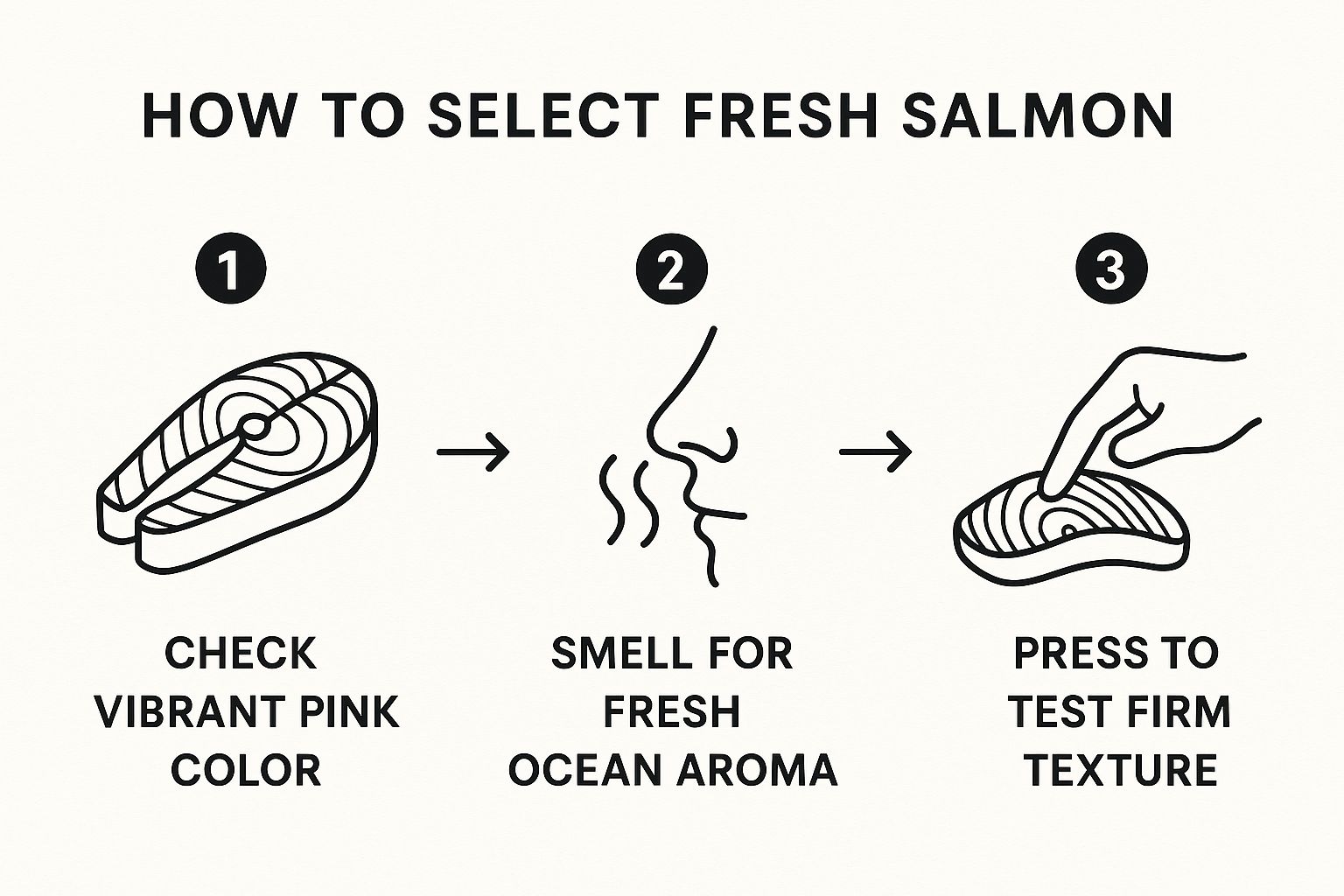Let’s be honest, nailing perfectly cooked salmon can feel like a culinary tightrope walk. You’re aiming for that sweet spot where the fish is moist and flaky, not dry and chalky. The secret isn’t some complicated chef’s trick; it’s all about temperature. For consistently delicious salmon, you’re looking for an internal temperature between 125-135°F. At this point, the flesh magically transforms from translucent red to a beautiful opaque pink and flakes with the gentle nudge of a fork.
This guide is your new best friend for getting it right every single time. We’ll walk through the three most reliable methods—pan-searing, baking, and grilling—so you can finally master the art of cooking salmon.
So, What’s the Big Deal With Salmon?
It’s no accident that salmon has become a superstar in home kitchens everywhere. Beyond its rich, buttery flavor, it’s packed with health-boosting omega-3 fatty acids. This combination of taste and nutrition makes it a smart and satisfying choice for any meal. In fact, its popularity is massive, with the global market hitting a staggering 3.7 million tons each year. You can dig deeper into the numbers by checking out this comprehensive salmon market report.
What I love most about salmon, though, is its incredible versatility. You can take the same fillet and create completely different dining experiences just by changing how you cook it. Craving that shatteringly crispy skin? A screaming hot pan is your answer. In the mood for something more delicate and tender? The gentle, even heat of the oven will get you there.
Getting the Fundamentals Right
Before you even think about firing up the stove, your journey to perfect salmon starts at the fish counter. A great meal is impossible without great ingredients. This handy infographic breaks down exactly what to look for when you’re buying a fresh fillet.
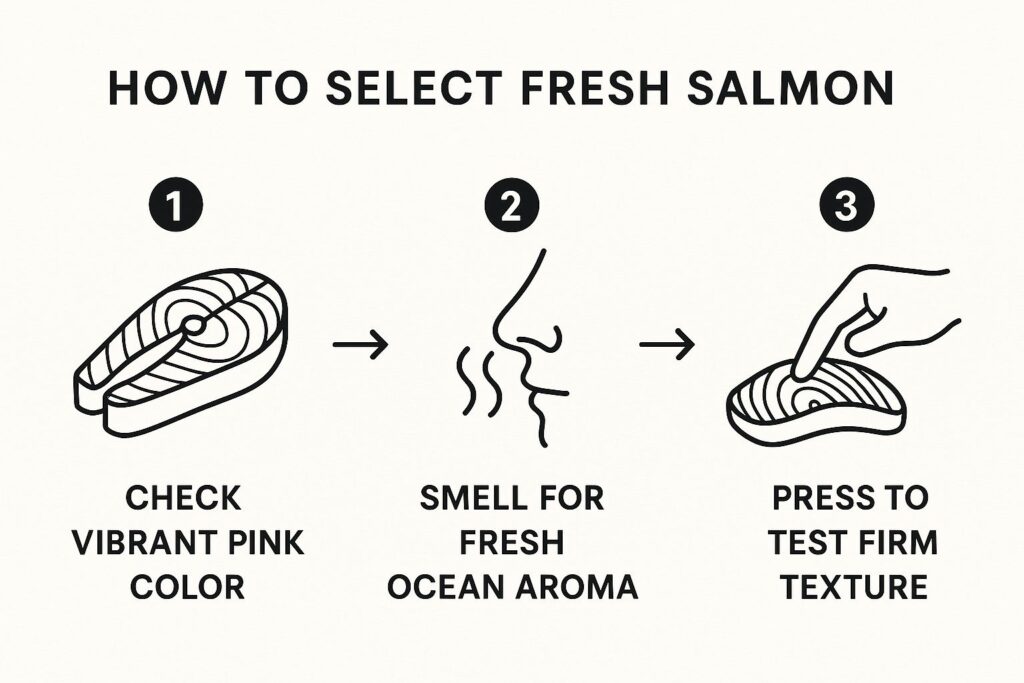
As you can see, it’s about using your senses. Look for vibrant, deeply colored flesh. It should smell clean and fresh like the ocean, not “fishy.” And when you gently press it, the flesh should feel firm and spring back. Once you internalize these cues, you’ll start to cook more intuitively, relying less on rigid recipes and more on your own judgment.
My goal for you is to get so comfortable with the process that you can cook amazing salmon on a whim, no recipe required. When you trust your technique, you unlock a new level of confidence in the kitchen.
To help you get there, let’s compare the most popular cooking methods side-by-side. This little cheat sheet will give you a quick overview of what to expect from each technique.
Salmon Cooking Methods At-a-Glance
| Method | Typical Temperature | Average Cook Time | Best For |
|---|---|---|---|
| Pan-Searing | Medium-High Heat | 6-10 minutes | Achieving crispy skin and a juicy interior. |
| Baking (Roasting) | 400°F (205°C) | 12-15 minutes | Hands-off cooking, especially for larger fillets or meal prep. |
| Grilling | Medium-High Heat | 8-12 minutes | A smoky, charred flavor perfect for summer cookouts. |
Think of this table as your quick-start guide. Now, let’s dive into the specifics of each method so you can choose the right one for any occasion and make perfectly cooked salmon a regular on your menu.
Choosing the Right Salmon at the Store
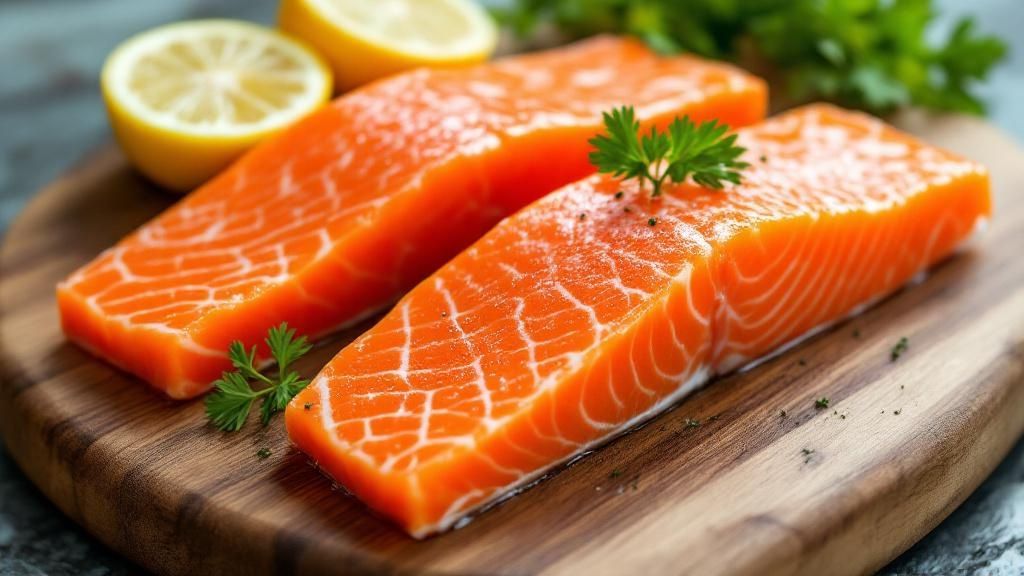
Honestly, a great salmon dinner starts long before you ever turn on the oven. It begins right here, at the fish counter. Picking a quality fillet is the single most important thing you can do to guarantee a delicious meal, as it sets the foundation for both flavor and texture.
The first choice you’ll likely face is between wild-caught and farm-raised salmon. Wild varieties, like Sockeye, are typically leaner with a much deeper, more complex flavor and a vibrant red color. On the other hand, farm-raised Atlantic salmon tends to be milder and has more fat, which not only makes it buttery but also a bit more forgiving if you accidentally overcook it. There’s no right or wrong answer—it just comes down to personal preference.
Spotting True Freshness
No matter which type you go for, freshness is non-negotiable. I’ve learned to spot a quality fillet by looking for a few tell-tale signs.
- Look for vibrant color. The flesh should appear bright and have a nice, moist sheen. Steer clear of anything that looks dull, faded, or has discolored spots.
- Give it a gentle press. If you can, poke the fillet lightly. It should feel firm and spring right back. If your finger leaves an indent, the fish is past its prime.
- Trust your nose. Fresh fish should smell clean and a little briny, like the ocean. If you get a whiff of a strong, unpleasant “fishy” odor, it’s a hard pass.
My Pro Tip: Never be shy about asking the fishmonger for a closer look or a quick sniff. Any good fish counter professional expects this and will be happy to help. It’s the best way to ensure you’re taking home a truly top-tier product.
Finally, don’t overlook the frozen section. Thanks to modern flash-freezing technology, which freezes the fish solid just moments after it’s caught, frozen salmon is often a fresher choice than the “fresh” fillets that have spent days in transit. Just make sure to thaw it properly overnight in the fridge and pat it completely dry before you start cooking.
The demand for quality salmon is only growing, thanks to its amazing health benefits and versatility in the kitchen. In fact, aquaculture now supplies about two-thirds of all the salmon we eat globally. You can learn more about this trend and the booming salmon market on GlobeNewswire.
The Secret to Restaurant-Quality Crispy Skin
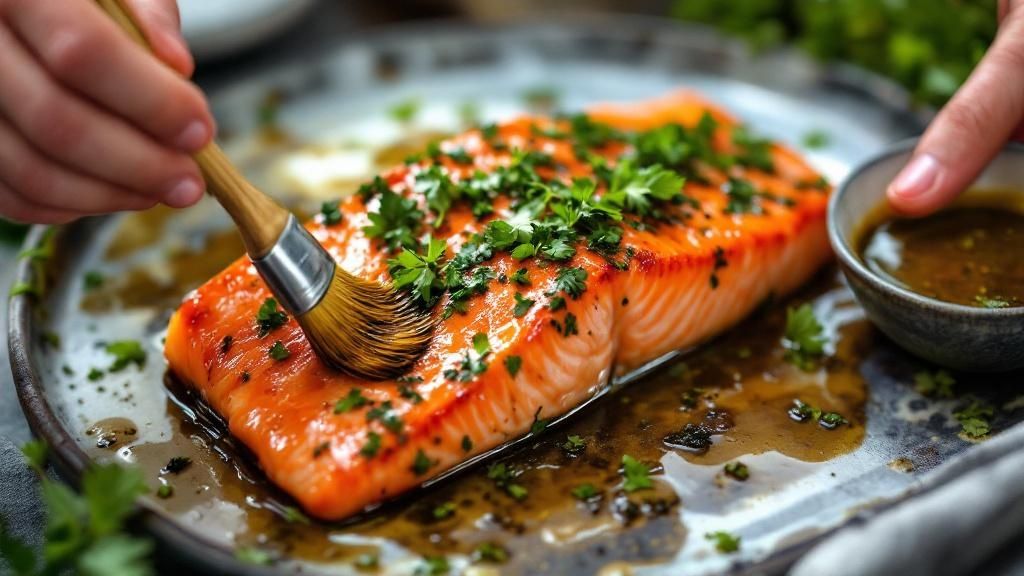
If you’ve ever had salmon at a great restaurant, you know what I’m talking about: that perfectly shatter-crisp skin giving way to moist, flaky fish. It seems like some kind of kitchen magic, but I promise it’s just technique. Good technique. And you can absolutely nail it at home.
It all boils down to two things: a completely dry fillet and a screaming-hot pan. Any dampness on that skin is your enemy. It will instantly create steam, and steamed skin is the opposite of crispy. So, before you even think about oil or salt, grab a few paper towels and pat that salmon skin until it’s as dry as you can possibly get it.
Setting Up for a Perfect Sear
The right pan makes a world of difference here. My go-to choices for this job are either cast-iron or stainless-steel. They hold heat like nothing else, giving you that intense, immediate sear you need to crisp the skin before the rest of the fish overcooks.
Get your skillet over medium-high heat and add just enough high-smoke-point oil (I like avocado or grapeseed) to coat the bottom. You’ll know it’s ready when the oil begins to shimmer. Season your dry salmon with salt and pepper, then carefully place it in the pan skin-side down, laying it away from you to avoid getting splashed.
The Chef’s Press: This is the one trick that changes everything. The second that fillet hits the pan, use a fish spatula to press down on it gently but firmly for about 30 seconds. Salmon skin naturally wants to curl up, but this simple press keeps the entire surface in contact with the hot metal, guaranteeing an even, golden crust.
Now, hands off! Let it cook without being disturbed. All the magic is happening now as the fat renders and the skin gets incredibly crisp. This usually takes about 5-6 minutes. You can actually watch the salmon cook from the bottom up as the color slowly creeps up the side of the fillet.
Finishing with a Flavor Baste
Once the skin looks amazing—deeply golden and crispy—it’s time to flip. This is where we add that final layer of restaurant-style flavor. Toss a tablespoon of butter, a smashed garlic clove, and a sprig of thyme or rosemary into the pan.
As the butter melts and starts to foam, tilt the pan towards you and use a spoon to baste that fragrant butter all over the top of the salmon. Keep spooning it over for about a minute. This not only infuses the fish with incredible flavor but also gently finishes the cooking process. And just like that, you’ve made perfect, restaurant-quality salmon.
Baking Salmon for Foolproof Flaky Results
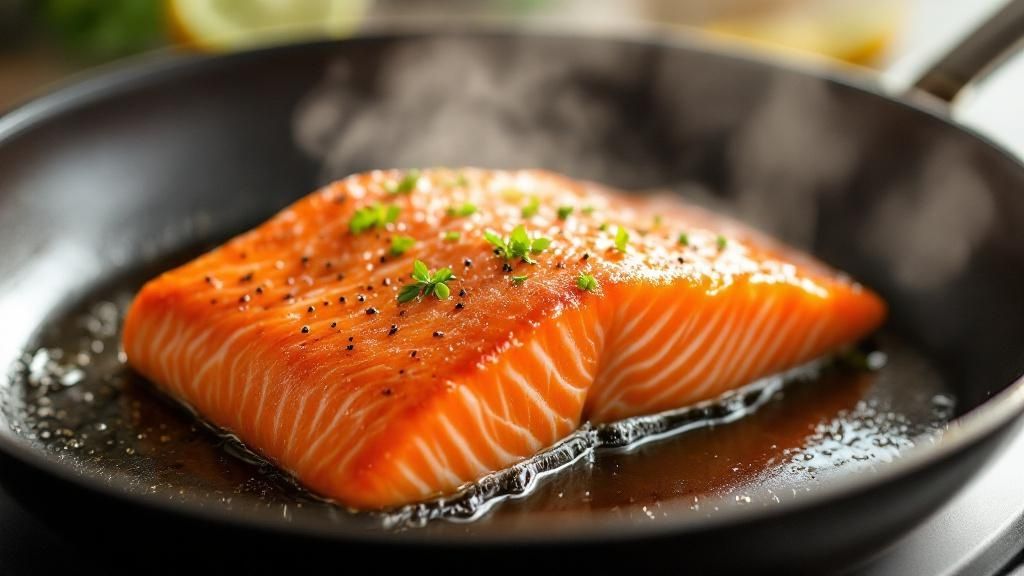
When you need a reliable, hands-off way to get dinner on the table, baking salmon is the answer. I turn to this method all the time because it’s the most forgiving technique out there. It delivers wonderfully moist and flaky results with almost zero fuss, which is a lifesaver on a busy weeknight.
But just because it’s easy doesn’t mean it has to be boring. Let’s talk about two fantastic ways to bake salmon that will make you look like a culinary pro. First up, the one-pan wonder: sheet-pan salmon.
The Classic Sheet Pan Method
This approach is my go-to for pure simplicity and efficiency. First things first, get your oven preheating to 400°F (200°C). That temperature is the sweet spot—hot enough to cook the fish through quickly but not so aggressive that it dries out.
Line a baking sheet with parchment paper. Trust me, you’ll thank yourself later when cleanup is a breeze. Pop your salmon fillet in the center, then surround it with your favorite vegetables. I love using asparagus spears or broccoli florets. Drizzle everything with a good olive oil and season it well.
Here’s a tip I’ve learned the hard way: don’t overcrowd the pan! Give the salmon and veggies some breathing room. When everything is too cramped, it just steams and gets soggy. You want everything to roast and get those delicious caramelized edges.
Elevate with En Papillote
Want to get a little fancier? For an even more impressive and incredibly tender result, you have to try cooking salmon en papillote (in parchment). It sounds complicated, but it’s not. This classic French technique is all about creating a sealed pouch with parchment paper.
You simply place the salmon inside the parchment along with aromatics. Think thin lemon slices, sprigs of fresh dill, and maybe a splash of white wine.
As the pouch bakes, it traps all that steam and moisture, gently cooking the salmon in its own flavorful juices. This method makes it almost impossible to overcook the fish, guaranteeing a fragrant and unbelievably moist fillet every single time.
This technique isn’t just for salmon; it works beautifully for all kinds of seafood. If you’re inspired to try another elegant but simple seafood dish, this delicious Crab Brûlée recipe uses a similar principle of gentle cooking to achieve its rich, creamy texture. It just goes to show that the simplest techniques often yield the most stunning results.
Mastering the Grill for a Perfect Smoky Char
There’s just something about the smoky flavor of grilled salmon that you can’t get anywhere else. But I get it—a lot of people shy away from it, haunted by the memory of a beautiful fillet sticking to the grates and falling apart. Let me assure you, grilling salmon is not only easy but also incredibly rewarding once you know a few key things.
Success on the grill really boils down to three simple, non-negotiable rules: a clean grill, a hot grill, and a well-oiled fish. Seriously. Before you even think about lighting the grill, give those grates a good, thorough scrape. Any leftover gunk from last weekend’s burgers is a guaranteed recipe for stuck fish.
Prepping for a Stick-Free Sear
First, get that grill preheating to medium-high heat. A properly hot grill is what gives you a fantastic sear and helps the salmon release cleanly when it’s done.
While the grill heats up, take your salmon fillets and pat them completely dry with a paper towel. This is crucial for getting that crispy skin. Then, brush all sides with a high-smoke-point oil (like avocado or canola) and season them generously.
Place the salmon skin-side down onto the hot grates. And now for the hardest part: leave it alone. Resist the urge to poke, prod, or flip it too soon. Give it about 6-8 minutes. You’ll know it’s ready to flip when it releases from the grates without any effort. If you have to force it, it needs more time.
A Game-Changing Technique: For a more subtle, aromatic smoke and a nearly foolproof, stick-free experience, try grilling on a cedar plank. Just soak the plank in water for an hour beforehand, place the salmon on top, and let it grill. The fish gently steams while absorbing an amazing woody flavor. It’s fantastic.
This hands-off grilling method makes for a perfect summer meal. If you’re looking for other great ideas for a get-together, this crowd-pleasing high-protein buffalo chicken dip is always a massive hit at my cookouts.
Once you get these simple grilling techniques down, you’ll be serving up perfectly charred, smoky salmon with confidence every single time.
Your Top Salmon Questions, Answered
Even seasoned cooks run into questions when making salmon. Perfecting it is a journey, and a little troubleshooting is just part of the process. Let’s walk through some of the most common hurdles you might face in the kitchen so you can cook with total confidence.
How Can I Tell When Salmon Is Done Without a Thermometer?
This is probably the number one question I get. The classic fork test is your most reliable friend here.
Just take a fork and gently press down on the thickest part of the fillet. If the fish flakes apart easily and has turned from a reddish, translucent color to a solid, opaque pink, it’s good to go.
Pro Tip: Watch out for that white stuff that sometimes oozes out. That’s just a protein called albumin. A little is normal, but a lot of it means the fish is overcooking. If you see a lot of white “beads” forming, get that salmon off the heat right away! A slightly underdone piece of salmon is always better than one that’s dry and tough.
Can I Really Cook Salmon Straight From Frozen?
You bet! It’s a fantastic time-saver for those busy weeknights.
To bake it from frozen, just give the fillet a quick rinse under cold water to remove any ice crystals, then pat it completely dry with a paper towel. Season it up and pop it into a 400°F (200°C) oven for about 15-20 minutes. This method is perfect for quick, healthy meals, like our super-popular Sunshine Dishes salmon bowl recipe, which is designed to work beautifully with frozen fillets.
What’s the Best Oil for Crispy Skin?
For that glorious, shatteringly crispy skin, you absolutely need an oil with a high smoke point. This lets you get the pan screaming hot—which is essential for a good sear—without setting off your smoke alarms.
Here are my go-to oils for the job:
- Avocado Oil: My personal favorite. It has a super high smoke point and a neutral flavor that lets the salmon shine.
- Grapeseed Oil: Another excellent neutral-tasting oil that can handle the heat.
- Canola Oil: Always a reliable and budget-friendly option.
- Clarified Butter (Ghee): This is fantastic if you want to add a rich, nutty flavor. Since the milk solids are removed, it won’t burn like regular butter.
A word of advice: save that expensive, grassy extra virgin olive oil for finishing. Drizzle it on after the salmon is cooked to add a burst of fresh flavor that would otherwise be lost in a hot pan.
At sunshine dishes, we believe happy meals start with simple, delicious recipes. Find your next family favorite on our blog! Visit us at https://sunshinedishes.com.

